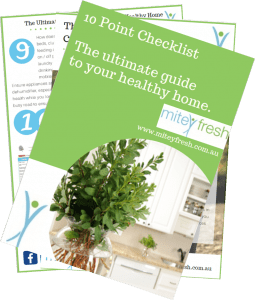Some time ago I was asked my opinion on Chronic Inflammatory Response Syndrome and it’s connection with mould, from a Building Biologists point of view. It’s such a huge topic that involves many professionals and research however I felt it was important that I documented my discussion as it raised some great points and may help you in your search for more information surrounding this topic.
Background information on CIRS and mould
Homes are generally considered to be safe and healthy living environments where people spend a large part of their time each day. The interaction of the home and the environment it is located in determines the quality of the indoor air and in turn impacts and determines occupant health and well-being.

Mould is ubiquitous throughout the world, found indoors and outdoors, growing virtually on any organic substance, as long as moisture and oxygen are present and with dust and dirt normally present, provides sufficient nutrients.
Its when buildings get wet or damp and stay damp for long periods of time, that microbial growths – moulds, fungi and bacteria grow on and decompose materials and furnishings. This microbial growth can result in significant increases of indoor concentrations of airborne mould spores, fragments, mycotoxins and microbial volatile organic compounds.
![]() When moisture intrusion or accumulation is discovered, the source should be identified and eliminated as soon as possible to stop microbial growth and building material degradation, health problems for the occupants and the deterioration of the buildings.
When moisture intrusion or accumulation is discovered, the source should be identified and eliminated as soon as possible to stop microbial growth and building material degradation, health problems for the occupants and the deterioration of the buildings.
Mould can be invisible and odourless in spite of causing problems. Only 25% of mould spores are viable, that is, able to germinate. Some moulds produce MVOCS creating damp, musty odours synonymous with water damaged buildings.
Mould is a sneaky health issue. There are many different symptoms that can show up as a result of mould illness. Following exposure to water damaged building interiors be at work, home or school, Shoemaker (2010) found illnesses acquired were quite similar to other inflammatory illnesses caused by exposure to biologically produced toxins he termed Chronic Inflammatory Response Syndrome or CIRS.
CIRS involves a systemic inflammatory response that results when an individual does not have the immune response genes to eliminate neurotoxins produced by their exposure to water damaged buildings.
CIRS affects multiple systems in the body according to Shoemaker. Causes patients suffering from exposure to biotoxins to exhibit multiple symptoms including fatigue, weakness, muscle cramps, memory problems, difficulties with concentration, disorientation and confusion, headaches, vertigo, light headedness, muscle aches, post-exertion malaise, cramping, joint pains without inflammatory arthritis, hypersensitivity to bright light, blurred vision, burning or red eyes, tearing, cough, asthma-like illness, shortness of breath, chronic sinus congestion, air hunger or unusual shortness of breath at rest, chronic abdominal problems including nausea, cramping, secretory diarrhoea, a propensity to experience static shocks as well as establish the underlying cause of Multiple Sclerosis, Chronic Fatigue Syndrome, fibromyalgia and depression.
Mould symptoms can differ from one person to another, even in the same household, and can show up either in the moment or long after your initial exposure.
Dr Ritchie Shoemaker discovered that 24% of the population are genetically pre-disposed to develop CIRS after exposure. CIRS is diagnosed through blood tests for known inflammatory markers and treated successfully, including now in Australia.
According to WHO (2009) relations between dampness, microbial exposure and health effects cannot be quantified precisely, no quantitative health-based guideline values or thresholds can be recommended for acceptable levels of contamination with microorganisms. When they do occur, they should be remediated because they increase the risk of hazardous exposure to microbes and chemicals. WHO (2009) recommends that dampness and mould-related problems be prevented.
So what is a Building Biologist and What do you do?
Building Biology examines the interaction between all living things and their natural and built environments and connects their impact upon the health and well-being of those who occupy them, synergistically providing us with an understanding of how to manage healthier homes, work places, schools and effectively enhance healthy, happy, productive occupants.
When nothing else seems to have worked and you and your family are still sick, a Building Biologist comes to your home to help you understand what’s going on. Analyse, assess and identify the adverse health hazards, helps you implement simple, immediate solutions to more complex mitigation so you and your family can become happy and healthy once more.
What does a Healthy Home Assessment cover?
Together, you and the Building Biologist look at indoor environment very thoroughly!
• your home inside and out
• the history of the house, the site, building materials and design,
• environmental allergens, mould, dust mites, pollen and pollution,
• bedding, furnishing materials, toys and clothing,
• moisture, ventilation, heating and cooling,
• chemicals, pesticides, cleaning and personal care products,
• pets, pet hair and dander,
• electrical appliances and telecommunication devices,
• drinking water, food packaging and kitchenware,
• health issues of every family member,
• and much more!
In essence, we determine exactly what you need to do to create a healthy outcome for you and your loved ones. You’ll receive a comprehensive understanding of the issues in your house, your environment and the issues that are likely to be causing you and your family adverse health problems.
How do people know when to call you?

What should they look for in their homes?
Are you always sick? Is it your home? Maybe you feel like you’re going crazy. Maybe nobody believes you when you say there’s something wrong. Or…maybe you’ve been right all along and it’s time to find a solution.
It can be frustrating when no-one listens. Can’t they see that something isn’t right?
You’re feeling tired and unhappy. Or your spouse is always complaining about headaches. Your child just isn’t getting better … the tension and unknowing is getting overwhelming.
So you head to the internet and find no help. A mess of contradictory information, scare tactics, pages of maybe this nonsense or maybe that, someone heard a story once from someone they knew one time about someone else…Confusing?
Your family and friends look at you with perplexity. Even your partner is starting to get frustrated. And your doctors … they mean well, but they just don’t get it.
Why won’t anyone believe you? All you want is to be healthy and normal again.
Can it really be all in your head? If it’s all in your head, why do you feel this way? If only there were something you could do. The good news is… There is.
I can imagine exactly how you must be feeling, locked into a chronic cycle of debilitating symptoms and spending endless amounts of money looking for a cure. When you’re not getting any better, and it starts to impact through loss of time at work or your child’s attendance at school, it starts to get more serious. You’ve tried everything and you’re at your wit’s end. So, tell me, what’s it like at your place?
Is bathroom mould ok or going to make you sick?
Bathrooms fundamentally are prime locations for mould invaders. Some types of mould do grow easily in showers, it’s the cellulose hungry mould that encourages mould growth and the water-resistant, shower surface material that discourages it. It doesn’t mean the mould in your bathroom is of the most dangerous variety.
Authorities do not recommend random laboratory testing, the only reliable method for determining what type of mould is growing in your shower. No matter what type of mould you have, the solution is the same, get rid of it!

What are your top 3 tips to help keep your home and therefore your family safe?
Get to know your indoor air! The best thing you can do for your home is to be well educated. Being knowledgeable about quality air rarely has problems, and if you do, you know how to solve them.
Air circulation inside and air exchange outside your home is often over looked. It’s the most important area of indoor air quality. A room or a building that has good air circulation and air exchange will rarely have issues like odours and stuffiness, poor health and productivity.
Tip 1: Open windows and doors VERY WIDE removing out particulates and gases that are making your air polluted.
Stagnant areas in your home that have poor circulation can be found behind your curtains, behind your furnishings, against walls like your lounge or bed or desk, cupboards and corners, cluttered rooms.
Tip 2: I HEAR you girlfriend, sometimes these areas are unavoidable. You can do your best to open cupboards and de-clutter to improve these spaces, but you may just have to take care of these areas manually. This is why it’s important to always have a damp micro fibre cloth handy to dust, wipe over, clean and freshen those areas, vacuum your rooms at least once a week and move the furnishings and hit all the stagnant areas.
For indoor air testing, taking the Breath Test is my personal favourite. It’s easy to do and so primal that we all have built within us – much more instantaneous ‘gut feeling’ this is not right and respond by moving away to safety. This action of breathing in and smelling, feeling, seeing and sometimes tasting are sensory responses well in advance to health responses such as sneezing, tickling throat, can’t stop coughing.
Tip 3: DO the Breath and Look Test at least once a week in different spots in the room and in your home. I like to check my indoor air every day. Ask other members of your family to sample breathing, sniffing and looking in rooms if you are concerned. And chat about your findings like mould, fragrances and perfumes, off-gassing from old and new materials, stagnant materials, wet building material smells.
Water damage indoors can be due to occupant activities like showering, cooking, laundering, driers. These activities produce water vapour that condenses on cold surfaces the walls, the windows, and the furniture. Or water damage can be due to poor maintenance of the building, gutter overflow as a result of heavy rain, broken plumbing and sewer system pipes overflow or faulty washing machines and fridges leaking and spilling onto the floor. These occurrences produce water flooding, pooling, inadequate drainage and porous materials absorb the water and stay wet for what seems forever.
Priority Tip: Dry up all water spills, leaks, floods within 48 hours! It is the building materials that have been soaked for more than 48 hours that are likely to be contaminated with mould.
Mould simply needs moisture, low ventilation and organic matter on which to grow. You can begin to see how it becomes an issue for many people.
Don’t let your inadequate indoor air quality make you and your loved ones unwell.
Towards healthier living, Carol Parr ♥
I’ve worked with asthma and allergy sufferers for over twenty two years, specialising in mould, dust mites, chemicals, EMFs and WiFi, building materials and water. When I’m not turning unhealthy rooms into healthier, relaxing and productive spaces, I’m most likely frightening my husband and children with numerous “let’s see what this does when …” projects. You can visit me here at www.miteyfresh.com.au
It’s all about breathing easier, working easier, living easier. Who do you know that would like that?
References:
Mold Survivor, 2001. Human health effects of indoor mycotoxin exposure in fungi – contaminated indoor environments. (Online). Available: http://www.mold-survivor.com/mycotoxinsfungi.html [November 10, 2015]
Moldy: A conversation with Ritchie C. Shoemaker, MD. 2015, (Online). Available: https://www.youtube.com/watch?v=i3oZ4-RJL_s [August 30, 2015]
Shoemaker, R., King-The, L, 2007. Inside indoor air quality: Environmental Relative Moldiness Index, (Online). Available: https://www.survivingmold.com/docs/Diagnosis/ERMI/Articles/ERMI_V26_p32_FiltrationNews_2007.pdf [December 3, 2015]
WHO Health Organisation. 2009. WHO Guidelines for Indoor Air Quality: Dampness and Moud. (Online). Available: http://www.euro.who.int/__data/assets/pdf_file/0017/43325/E92645.pdf [September 30, 2015]






